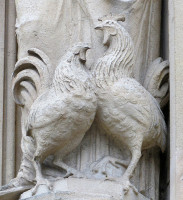
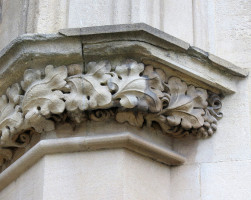
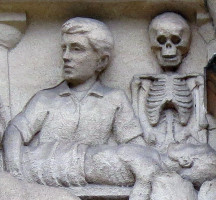
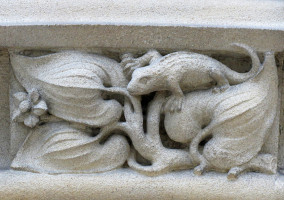
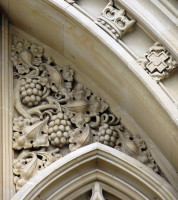
A little out of the centre of Cardiff, on Newport Road, is the surviving tower of Queen’s Building, the one time Department of Physiology of the National School of Medicine of Wales, and now part of the University. The building is of interest to these pages for its sculpture, not so much the two full size statues and four portrait heads, though these are decent architectural sculpture of their type, but for the smaller ornamental animals and plants which decorate the tower.
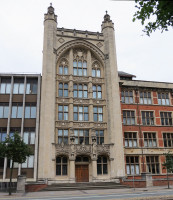
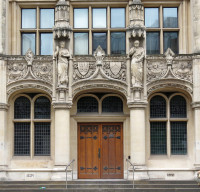 Cardiff's Queen's Building, and the portico.
Cardiff's Queen's Building, and the portico.
The building was put up from 1915, as is recorded in two diamonds in the spandrels at the top of the frontage, the architect being E. M. Bruce Vaughan, a native of Cardiff, and opened by the Prince of Wales six years later, noted on a panel at the base. It stands five storeys high, with balustrade or parapet at the top and pinnacles to either side, these forming the tops of attached pillars reaching all the way down to the ground; the three bays between are recessed behind a Gothic arch under the balustrade.
The principal sculpture is above the ground floor, centred on the doorway, of course, with bands of repeating relief sculpture above the next three floors, and then larger sculptural details in the tracery above the topmost floor. The whole frontage is carved in beautiful Bath stone.
Statues of Hippocraftes and Asclepius.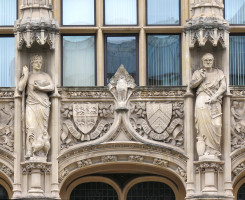
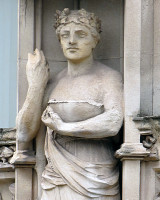
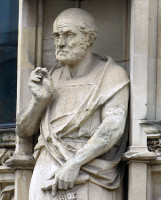
The two statues on either side of the doorway, raised on bulky attached pillars and within proper Gothic niches, are Asclepius and Hippocrates. Both of these have been cleaned and repaired, by the look of them, but the projecting arms and feet are crumbling. The statue of Asclepius is shown as a middle-aged Classical figure - more Roman-looking than Greek - wearing a drape, leaving upper chest and powerful arms bare. The one arm is crooked and holds a bowl, the other holds, or held, the top of his long staff. At his feet, two cockerels stand - cockerels were the chosen sacrifice in shrines to Asclepius. (Some examples of the staff of Asclepius, normally with a snake entwined about it, is noted on the snakes page). To the right stands the statue of Hippocrates, whose medical work is still directly relevant today in the Hippocratic oath. is shown as an ancient, bearded and bald-headed, and with more drapery. He holds an unrolling scroll, with the words ‘Vios vrahis techni makri’, or ‘The life is short, the art [knowledge] long'. His other hand perhaps once held some instrument or pen, but has crumbled away. At his feet, also damaged, is a tall pot or jug.
Pasteur, Lister, Hunter and Jenner portrait busts, and central shields.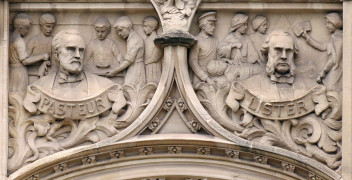
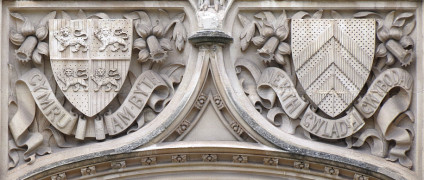
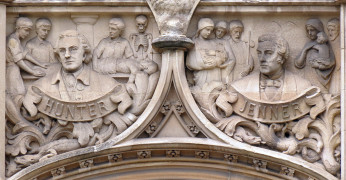
Between this pair, above the door, is a central bird in relief – a large owl, much damaged (this website has a small page on owl sculpture), and beneath and beside this are two heraldic shields with mottoes in Welsh, and nicely carved daffodils filling the space. To left and right of the principal figures, thus above the side windows, are instead of shields, carved portrait busts, labelled as Pasteur, Lister, Hunter and Jenner (you will need to click the pictures to enlarge to see them properly), all most appropriate for a medical building. Surrounding each bust is a cluster of small figures, doing various medical things, dissolving below into acanthus leaves. Above this frieze is a thin band of much undercut sculptural decoration with small animals and leaves, and beneath, little square panels around the windows, also much carved; further detailed carving abounds wherever opportunity offers. It really is a most lively ensemble: mice, frogs, weasels attacking hamsters, coiled snakes, tadpoles, and little lizardlike creatures, all crawling amongst leaves. Between the busts, raised central portions contain rather damaged relief sculpture of some wild man or pithecus on one side, and a stylised eagle with folded wings on the other (if you like eagle sculpture, see this page). The briquettes around the windows have more beasts among foliage and flowers – lizards, little crocodilian things, more mice, and a squirrel with large perked-up ears, and the odd mythological creature.
Some of the small animal carvings.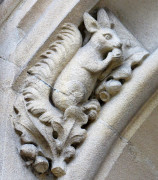
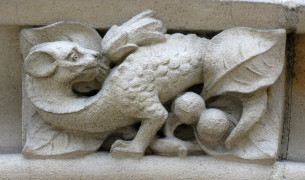
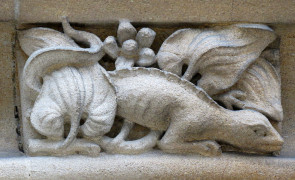
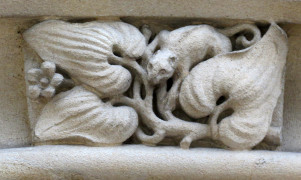
The higher levels, as mentioned, also have bands of sculpture, and this consists of flowers, of convolvulus, poppies perhaps, and then above, anemones, each panel having a central wreath enclosing a shield or cabochon – no animals here, as the designer appreciated that they would not be visible from the ground. The uppermost sculpture in the tracery above the top floor is larger foliage and flowers still – wild rose, thistle, quince, and a grapevine, and smaller squares showing various devices: stylised leaves, crowns, crosses, fleur des lys.
Sculptural friezes higher up: plant sculpture.

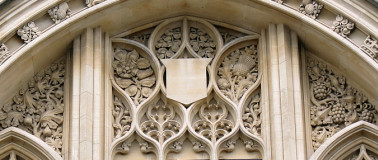
The tower is clamped between two long, four storey blocks. That to the left as we look at it is an insensitive modern hideousity, of a character only an educational institution could possibly conceive or execute, and that to the right is a red brick and pale stone Victorian block. This latter is unremarkable, except that under the balustrade on top is a thin band of repeating decorative sculpture, with several larger animal gargoyles emerging – these are reminiscent of Cardiff’s Animal Wall, described elsewhere on this site (see link below). Thus we have an eagle, a lion springing onto a python, and a bear which really is a homage to the Animal Wall, all really rather entertaining, and a shame they are so high up it is easy for the casual passer-by to miss them.
Animals from the Victorian block: statues of bear, lion mauling snake, and eagle.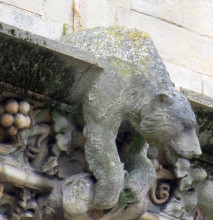
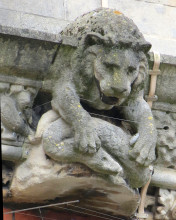
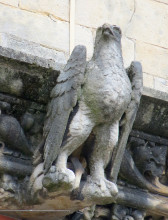
This page was originally part of a 'sculpture of the month' series, for April 2015. Although the older pages in that series have been absorbed within the site, if you would wish to follow the original monthly series, then jump to the next month (May) or the previous month (March). To continue, go to the bottom of each page where a paragraph like this one allows you to continue to follow the monthly links.
Also in Cardiff: Glamorgan County Hall sculpture // Boer War Memorial // and the Animal Wall // Animal Sculpture page
Sculpture in some towns in England
Visits to this page from 1 Apr 2015: 8,181